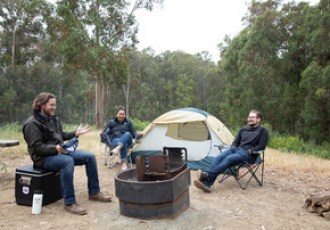BestReviews is reader-supported and may earn an affiliate commission. Details
We recommend these products based on an intensive research process that's designed to cut through the noise and find the top products in this space. Guided by experts, we spend hours looking into the factors that matter, to bring you these selections.

You need a sleeping bag for an upcoming hiking trip. You find yourself scrolling through pages and pages of similar-looking bags. Your head starts to fill with all of the possibilities, prompting a flow of questions. How much should the bag weigh? Are there different insulation options? What’s the difference between a backpacking sleeping bag and a regular sleeping bag? Do I need to purchase both? How do I know?
A little more research shows that backpacking sleeping bags differ in several ways from camping sleeping bags, and a backpacking sleeping bag is what you’re looking for. They are made to be more lightweight, to pack down smaller, and to be more efficient, providing a greater amount of warmth in a smaller size.
Now you’ve narrowed your search to backpacking sleeping bags in particular. And yet, you still have hundreds of options. It could be that you’re looking for specific features or certain colors. Whatever your situation, we’ve got a shortlist of great backpacking sleeping bags for you, and we provide the information you need to navigate your shopping experience.

Each backpacking sleeping bag has a temperature rating that reflects the minimum temperature in which the bag will keep you warm. It’s recommended that you choose a temperature rating slightly lower than what you expect to experience. That way, you’re prepared if the weather suddenly turns colder on you.
The average backpacking sleeping bag will keep you warm in temperatures ranging from 20°F to 30°F. However, a backpacking sleeping bag designed for extreme cold will work in temperatures as low as 0°F.
There are two types of insulation to know about: down and synthetic. Down insulation is a pricier option, but it also provides more warmth and weighs less. For those who don’t know, down comes from underneath the outer feathers of geese or ducks. Its purpose is to keep the birds warm and insulate their bodies from the cold. Humans adopted the use of down for keeping themselves warm.
Synthetic insulation runs a little cheaper than down insulation, and for the most part, it accomplishes the same purpose. Synthetic insulation will keep you warm, but it weighs more than down. A positive feature of synthetic bags is that they keep you drier in wet conditions.
If you prefer to sleep in a hammock instead of a tent, opt for a warmer sleeping bag as sleeping with the air around you is colder than sleeping on the ground.
Most backpackers think the lighter the sleeping bag, the better. The weight of the sleeping bag depends on the amount of insulation as well as what the rest of the bag is made of. It’s recommended to shoot for a backpacking sleeping bag that weighs three pounds or less. It will state somewhere on the sleeping bag packaging how much the entire bag weighs.
If you’re looking for greater warmth and comfort in a down bag, consider reducing the weight of other pack items so you can comfortably carry a slightly heavier sleeping bag.
Sometimes folks don’t know if they are going to go camping more or backpacking more. They want to purchase a sleeping bag that would work for both types of excursions. Here’s the trick: a camping sleeping bag will not always work for backpacking, but a backpacking sleeping bag will always work for camping.
The key is how much the bag weighs and its bulkiness. Backpacking bags are made to be lightweight. Camping sleeping bags aren’t made to be light or compact because they aren’t meant to be carried for long distances.

On the lower end of the price spectrum, a backpacking sleeping bag will cost between $20 and $30. These will definitely support you in temperatures between 20°F and 30°F. There won’t be many other features or pockets because this price point is the most basic.
Between $40 and $60, you’ll find an array of mid-range backpacking sleeping bags. These bags can help you withstand temperatures as low as 15°F and tend to have more features.
If you’re willing to pay over $60, you’ll find many choices that are larger — some that are designed for multiple people. You will also find sleeping bags that are able to keep you warm in below-freezing temperatures.

A. There are specific sleeping bags made for more than one occupant. For example, queen-size double sleeping bags are comfortable for a pair of people. If a sleeping bag was created for only one occupant, it’s recommended to not try to stretch it for a second person.
A. Yes, but it will most likely increase the weight of the sleeping bag. The carrier the sleeping bag comes in is lightweight and waterproof to protect the sleeping bag. If you use a bag of your own, keep in mind that you might be losing those qualities.
A. It depends on what you’re wearing and how many layers. A sleeping bag keeps your body heat inside of it to keep you warm. If you’re wearing so many layers that your body heat isn’t released inside the bag, it’s possible for you to actually be less warm than you could be.
Get emails you’ll love.
Learn about the products you’re wondering if you should buy and get advice on using your latest purchases.
